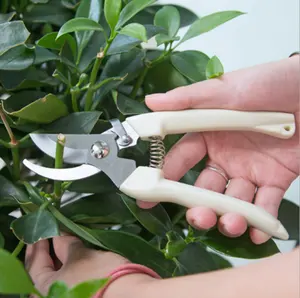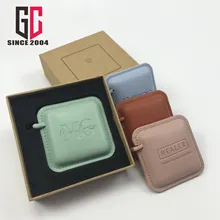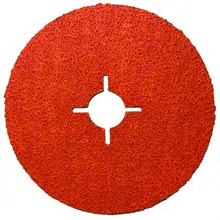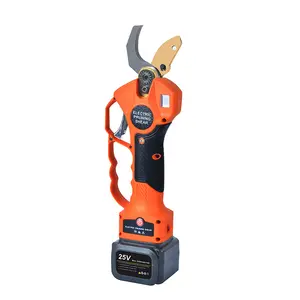Introduction
Gardening is an art that requires the right tools to create a masterpiece. Among these tools, small pruning shears hold a significant place, acting as the paintbrush that shapes and maintains the health of your garden. This article delves into the importance of pruning in gardening, the essential role of small pruning shears, and the different types available. It also guides you on choosing the right pruning shears for your garden, factors to consider when buying, and how to maintain them for longevity and performance. Whether you're a seasoned gardener or a beginner, this comprehensive guide will help you maximize your garden's potential.
The Importance of Pruning in Gardening
Pruning is a crucial practice in gardening, applicable to both young and mature plants. It involves selectively removing specific parts of a plant, such as buds, branches, or roots, to maintain their health and aesthetics. Pruning is also essential for timing and knowing where and how to cut. It improves the health of plants by removing dead, diseased, and injured parts, thus enhancing their vigor and aesthetic qualities. Additionally, pruning encourages good growth patterns, improves air circulation, and can even increase fruit production.
Why Small Pruning Shears are Essential
Small pruning shears are essential tools for any gardener. They are perfect for precise cuts on small stems, flowers, or herbs. Some models, being compact in size, are easier to control than other heavy-duty styles. These shears are designed for both left- and right-handed users. However, it's important to note that the cutting capacity of these shears can vary, and they may not be suitable for cutting thick branches.
Different Types of Small Pruning Shears
There are four main types of small pruning shears that are essential for any gardener. First, Bypass Pruners, which are ideal for live plants and green wood. Second, Straight Blade Pruners, perfect for precision cuts. Third, Anvil Pruners, best for deadwood as they can cause damage to live plants. Lastly, Ratchet Pruners, which are similar to anvil pruners but have a mechanism that cuts in stages, making it easier on the hands. Each type has its unique features and applications, making them suitable for different pruning tasks.
Bypass Pruners
Bypass cutting tools have two sharpened blades that pass over each other to make a clean and precise healthy cut in a scissor action. They are ideal for cutting delicate stems as the bypass action is less likely to cause bruising and damage to the stems. The design of the blades on secateurs make it easy to get into small gaps and to prune side stems flush with main stems. However, never use your bypass secateurs to cut through stems thicker than the recommended cutting diameter, as this can easily cause damage.
Anvil Pruners
Anvil pruners, similar to a knife and chopping board, have a sharp blade that meets a flat base to cut through material. They offer power, making them ideal for tougher branches and dead wood. However, their crushing action can damage live plant tissue, leading to longer healing times. Anvil pruners are recommended for pruning dead wood and hardier stems where more power is required.
Snips
Snips are perfect for intricate work on flowers and small stems. These small pruning shears are designed for both left- and right-handed users, offering versatility. Some models can cut branches up to ¾ inches thick, although this can vary depending on the type of branch. However, their size and precision make them an excellent choice for gardeners who need to make delicate cuts on their plants.
Choosing the Right Pruning Shears for Your Garden
Choosing the right pruning shears for your garden depends on several factors. Consider your hand size, grip strength, the type and amount of pruning you do, and your budget. There are two basic types of pruners – bypass pruners and anvil pruners. Bypass pruners are generally recommended for their clean cuts and versatility. Not all pruning shears allow you to replace parts that break or wear out, so consider this when choosing a quality tool. Ergonomic design can reduce wrist strain and make pruning more enjoyable. Lastly, consider the size and weight of the pruners, as heavier ones can cause more fatigue.
Factors to Consider When Buying Pruning Shears
When buying pruning shears, consider comfort, grip, longevity, and ease of use. The performance of shears can differ significantly, even if they look similar. Some models are lightweight, comfortable, and reduce hand fatigue, making them ideal for medium to large hands. Others are simple yet rugged, performing well even after 100 cuts. Some offer a unique rolling cam gear mechanism, delivering more cutting power with less effort. Always consider the size, weight, and handle comfort of the shears, as well as the durability of the blade.
Size and Weight
Lightweight pruning shears are an ideal choice for light day-to-day pruning. They reduce stress on user hands and wrists. Some models measure around 8-1/2 inches long and weigh only 8.7-ounces. Their light metal handles are forged for durability. A cushioned stop keeps the blades from opening unexpectedly or overly wide, enhancing its user-friendly design. This compact size and weight make it a practical tool for precise pruning tasks.
Blade Material
Pruning shears come with different types of blades: stainless steel, carbon steel, and titanium coated. Stainless steel blades have high corrosion resistance due to a protective chromium oxide layer, but they may not last long. Carbon steel blades, with a higher carbon content, offer more malleability, durability, and better heat distribution, but they can corrode and stain quickly. Titanium coated blades strike a balance between durability, sharpness, and anti-corrosion. The titanium coating strengthens the blade, prevents corrosion, and after being sharpened a few times, it exposes the steel edge underneath, providing a superior edge with higher strength and resistance to corrosion.
Handle Comfort
Some pruning shears are designed with user comfort in mind. Their handle is shaped to act as an extension of the forearm, preventing the pruner from sliding through the hand. These pruners also feature a revolving handle for extra comfort, making it suitable for every type of pruning. The ergonomically designed cushioned-shock absorber softens the cutting impact, reducing stress on the user's hands and wrists. This lightweight construction and handle design resist slipping, making it an ideal choice for light day-to-day pruning.
Maintenance and Care for Your Pruning Shears
Maintaining your small pruning shears is crucial for their longevity and performance. Regular sharpening is essential, and you can use a file, sharpening stone, or steel wool for this purpose. Lubrication is also important to keep the mechanism smooth. Cleaning your shears is another key aspect of maintenance. A simple daily clean can keep them in good shape, while a seasonal deep clean can ensure they're ready for the next pruning season. Remember, proper care can enhance the effectiveness of your shears and extend their lifespan.
Conclusion
In conclusion, small pruning shears are an indispensable tool for any gardener. They not only help maintain the health and aesthetics of your plants but also enhance their vigor and productivity. Choosing the right pruning shears depends on various factors, including your hand size, grip strength, pruning needs, and budget. Comfort, grip, longevity, and ease of use are crucial considerations when buying pruning shears. Regular maintenance, including sharpening, lubrication, and cleaning, can significantly extend the lifespan and effectiveness of your shears. With the right pruning shears in hand, you're well-equipped to create and maintain a thriving garden.











































 浙公网安备 33010002000092号
浙公网安备 33010002000092号 浙B2-20120091-4
浙B2-20120091-4